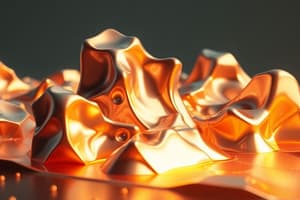Podcast
Questions and Answers
Which state is favored at room temperature for materials with large bonding energies?
Which state is favored at room temperature for materials with large bonding energies?
- Gas
- Liquid
- Plasma
- Solid (correct)
What does a steep slope on the force-versus-interatomic separation curve indicate?
What does a steep slope on the force-versus-interatomic separation curve indicate?
- Low thermal expansion
- High mechanical stiffness (correct)
- More flexibility
- Strong covalent bonds
What type of bond involves the valence electrons in solids?
What type of bond involves the valence electrons in solids?
- Ionic
- Metallic
- Covalent
- All of the above (correct)
What correlates with a low coefficient of thermal expansion for materials?
What correlates with a low coefficient of thermal expansion for materials?
Which type of energy leads to the gaseous state being favored at room temperature?
Which type of energy leads to the gaseous state being favored at room temperature?
How does the modulus of elasticity relate to the shape of the force-versus-interatomic separation curve?
How does the modulus of elasticity relate to the shape of the force-versus-interatomic separation curve?
What term is used to describe the directionality of ionic bonding?
What term is used to describe the directionality of ionic bonding?
In an ionic material, what is the requirement for the nearest neighbors of positive ions?
In an ionic material, what is the requirement for the nearest neighbors of positive ions?
What is the general range of bonding energies for ionic materials in kJ/mol?
What is the general range of bonding energies for ionic materials in kJ/mol?
Which type of materials are characterized by being hard, brittle, electrically insulative, and thermally insulative?
Which type of materials are characterized by being hard, brittle, electrically insulative, and thermally insulative?
What properties of ceramic materials are a direct consequence of electron configurations and/or the nature of the ionic bond?
What properties of ceramic materials are a direct consequence of electron configurations and/or the nature of the ionic bond?
Flashcards are hidden until you start studying
Study Notes
Ionic Bonding Overview
- Ionic bonding occurs between metallic and nonmetallic elements, positioned at opposite ends of the periodic table.
- Metallic atoms release valence electrons, forming cations, while nonmetallic atoms accept these electrons, forming anions.
- This electron transfer results in both atoms achieving stable noble gas electron configurations.
Sodium Chloride as a Classic Example
- Sodium chloride (NaCl) serves as a quintessential example of ionic bonding.
- A sodium atom transfers its one 3s valence electron to a chlorine atom, resulting in sodium acquiring a positive charge and a smaller ionic radius similar to neon.
- The chlorine ion gains an electron, leading to a net negative charge and an electron configuration resembling argon, with a larger size than the original chlorine atom.
Characteristics of Ionic Bonds
- Ionic bonding is characterized by coulombic attraction between positively and negatively charged ions.
- The attractive energy (EA) between isolated ions is inversely related to the interatomic distance, expressed as EA = −A/r.
- A constant A relates to the charges of the ions and their separation, derived from the equation A = 1/(4πε0 (|Z1|e)(|Z2|e)).
- Ionic repulsion is described by repulsive energy (ER), with ER = B/r^n, where B and n are constants specific to the ionic system.
Studying That Suits You
Use AI to generate personalized quizzes and flashcards to suit your learning preferences.




